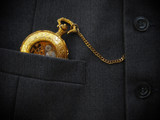The Beginner’s Guide to Pocket Watches

Pocket watches have burst back onto the scene since coming into fashion again in 2015. The cyclical nature of fashion trends has led to this old accessory being back in the spotlight despite mobile technology seemingly replacing its function.
Modest mechanical devices are an elegant treasure in today's technology-saturated world, making them a fantastic gift idea. Pocket watches can make for a unique, meaningful and stylish wedding gift, for example.
With so many vintage and second-hand pocket watches back on the market since the rebirth of this trend, it’s important to know how to find one that is authentic, in good condition and of high quality.
Components of a Pocket Watch
There are two major components to most pocket watches: the watch case and the watch movement. The movement refers to the inner mechanism that operates the timekeeping function of the watch. The watch case is the outer protective cover, including the winding stem, crown and crystal.
People often bought these two components separately, creating different combinations to cater to their personal style. Cases could come in a range of styles and metals from gold to sterling silver. Hunter cases, for example, feature an openable metal lid which closes to protect the crystal, hands and dial.
Identifying an Authentic Vintage Pocket Watch
Identifying a vintage pocket watch is similar to examining an old car. You may be able to tell if a car is a vintage but you can’t know its true value unless you know its year, model, engine size and type, transmission, special features, its condition and how far it has driven.
The same principle applies for vintage watches. At the very least, you need to know who manufactured it and where it was made before you can understand its value. Vintage experts will be able to determine the value of a vintage pocket watch by finding out as much information as possible about the model, age, size, grade, quality and unique features of the watch.
Age
Figuring out the age of a pocket watch is easier for some than it is for others. For example, a lot of American watches have serial numbers that help to distinguish their specific age. The age of many other watches, particularly Swiss and European watches, is much harder to determine.
Since they lack serial numbers, the age of these watches needs to be determined by examining the movement and the way they are constructed. You need a lot of experience to identify the age of a watch using these observations.
Quality
Determining the overall quality of a watch comes down to whether the best materials were used, the quality of craftsmanship, and how fine the finish is. You should also be able to hear a clean, crisp ticking with a faint metallic ringing. Signs of good quality include polished plates, gold components, blued screws, rounded spokes and a high jewel count.
The jewels we’re talking about here aren’t the decorative sort but the ones used within the mechanism of the watch itself. Jewels provide a very smooth, hard and long lasting bearing surface within the watch, which reduces friction and keeps it in excellent shape. Keep in mind that not all vintage watches are well made, so you should get an expert to determine the true quality of a pocket watch before purchasing it.
Pocket watches are a beautiful and unique accessory for the modern age, which makes them amazing gifts. If you’re looking for a vintage pocket watch that you can be sure is top quality, authentic and in marvellous condition, browse the collection at Harrington & Co. Get in touch with us if you have any questions about pocket watches or other vintage accessories.
Explore our collection online or give us a call on 07 3891 3880.
